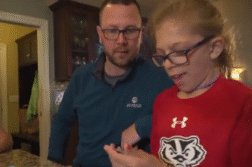INDIANAPOLIS, Ind. (Ivanhoe Newswire)— Right now, there are as many as 240,000 survivors of childhood cancer. Many are now young adults and may be struggling with long-term health effects of treatment. Researchers are studying the benefits of exercise on this special group of survivors of cancer kids.
Kids with cancer now have an 84 percent chance of surviving five years or more thanks to advancements in treatments. But those life-saving therapies often have long-lasting consequences.
Melissa Sherman, research assistant at the Indiana University Regenstrief Institute described to Ivanhoe, “They have a higher rate of chronic conditions like Type 2 diabetes, cardiovascular disease, just premature aging, things that we normally wouldn’t expect to see.”
Sherman and colleagues are studying the impact of a specialized exercise program on cancer survivors between the ages of 15 and 39 who had at least three months of chemotherapy. Participants are undergoing a supervised 12-week program of cardiovascular exercise, stretching and strength training. Researchers are measuring the impact of the exercise on balance, heart health, sleep, and fatigue.
“Muscular strength is improving, cardiovascular fitness level, or even being able to do small things like walk up the stairs,” Sherman explained.
Exercise that may turn back the clock for young cancer survivors.
Researchers are also measuring the impact of exercise on survivor’s mental health. Sherman says the benefits of exercise on cancer patients have been well-documented in older adults, but this is one of the first times scientists are measuring the benefits in adolescents and young adults.
Contributors to this news report include: Cyndy McGrath, Executive Producer & Field Producer; Kirk Manson, Videographer; Roque Correa, Editor.
To receive a free weekly e-mail on Medical Breakthroughs from Ivanhoe, sign up at: http://www.ivanhoe.com/ftk
Sources:
https://www.acco.org/us-childhood-cancer-statistics/
https://clinicaltrials.gov/ct2/show/NCT04265638
MEDICAL BREAKTHROUGHS
RESEARCH SUMMARY
TOPIC: CANCER KIDS: GET UP AND GO!
REPORT: MB #4859
CANCER: Cancer begins in cells which are the building blocks that form tissues. Tissues make up the organs of the body. Cells grow and divide to form new cells as the body needs them. When cells grow old, they die, and new cells take their place. Sometimes, this orderly process goes wrong, and new cells form when the body does not need them, and old cells do not die when they should. These extra cells can form a mass of tissue called a growth or tumor. Tumors can be benign, which are non-cancer and non-life threatening or malignant which are cancerous and may be life threatening. The stage of a cancer is an expression of how advanced the disease is in the body. It specifically refers to the size of the malignant tumor found. Stages range from 0 through 4, with Stage 0 non-invasive and a small tumor to Stage 4 which is a very advanced and large tumor.
(Source: https://www.americancancerfund.org/cancer-101/?gclid=Cj0KCQiA8dH)
CANCER IN CHILDREN: There are differences in the types of cancers that children tend to get, as well as how they are treated. Unlike cancers in adults, childhood cancers are not strongly linked to lifestyle or environmental factors and only a small number of childhood cancers are caused by DNA changes passed from parents to their child. With some exceptions, childhood cancers tend to respond better to certain treatments. This might be because of differences in the cancers themselves and because children’s treatments are often more intense. Also, children usually do not have many of the other health problems that adults with cancer might have, which can often get worse with treatment. On the other hand, children’s bodies are still growing, and they are more likely to have side effects from some types of treatment. For example, young children are more likely to be affected by radiation therapy. Many cancer treatments also can cause long-term side effects, so children who have had cancer will need careful follow-up for the rest of their lives.
(Source: https://www.cancer.org/cancer/cancer-in-children/differences-adults-children.html)
EXERCISE FOR CHILDREN CANCER SURVIVORS: Although more than 80% of children diagnosed with cancer in the US today will become long-term survivors, parents worry about the long-term effects of treatment. More than 60% of long-term survivors have at least one chronic health condition after childhood cancer treatment, and more than one-quarter have a severe or life-threatening condition. Children with cancer experience impaired cardiorespiratory fitness and physical function during and after treatment restricting their ability to engage in social activities including sports, leisure activities, and school. Many of the health problems experienced by cancer survivors due to their cancer or late effects of therapy can be helped by regular physical activity. It improves physical fitness, strength, flexibility, and balance, reduces risk for chronic illnesses, reduces risk for obesity, promotes bone health, improves mental health, improves cognitive function, increases confidence, and provides opportunities for social interactions. Says Melissa Sherman, Graduate Research Assistant at the Indiana University School of Health and Human Services, “There are a lot of developmental things going on both physically and mentally that treatments affect. Exercise has been shown to lessen the side effects and risks as far as Type 2 diabetes, obesity, and cardiovascular disease. So just overall, exercise is a real form of medicine for children cancer survivors.”
(Sources: https://jamanetwork.com/journals/jamaoncology/article-abstract/2767388, https://bmcmedicine.biomedcentral.com/articles/10.1186/s12916-020-01634-6, https://together.stjude.org/en-us/life-after-cancer/healthy-living/physical-activity.html and Interview with Melissa Sherman, Graduate Research Assistant at Indiana University School of Health and Human Services)
FOR MORE INFORMATION ON THIS REPORT, PLEASE CONTACT:
JENNIFER FARRELL WALKER
If this story or any other Ivanhoe story has impacted your life or prompted you or someone you know to seek or change treatments, please let us know by contacting Marjorie Bekaert Thomas at mthomas@ivanhoe.com




